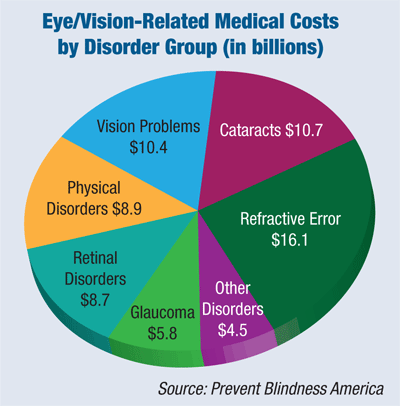 |
At a cost of $139 billion per year, vision problems are among the most expensive health issues in the nation, according to PBA’s report, “Cost of Vision Problems: The Economic Burden of Vision Loss and Eye Disorders in the United States.
“We feel that we now have a true estimate of the current and growing costs of eye disease in this country,” says Hugh R. Parry, president and chief executive officer of PBA. “Armed with that information, we can address the need for increased prevention, research and health care options.”
Co-author John Wittenborn presented an overview of the data at the second annual Focus on Eye Health National Summit in Washington DC on June 18. He summarized a breakdown of estimated costs of eye disorders and vision loss to government ($47.4 billion), private insurance ($20.8 billion in direct medical costs and $1.3 billion for long-term care), and patients and their families ($71.6 billion).
This data serves as an update to a similar 2007 PBA report, and provides a much more comprehensive view of the economic challenges associated with vision problems.
“This study highlights the significant lack of funding we dedicate to the prevention of vision problems,” says Jeff Todd, PBA’s chief operating officer. “Currently, the federal government allocates just under $500,000 to support the work of the CDC’s Vision Health Initiative. When compared to the $139 billion annual cost, that comes out to significantly less than one cent toward prevention of every dollar that vision problems cost our country.”
In addition to a revised methodology, the new report includes cost data across the age spectrum—for the first time including children—and considers all disorders related to the eye.
“It gives us a baseline estimate of the total burden in cost,” Mr. Wittenborn says. “So, the next question is, ‘What do we do to start mitigating this burden?’ It underscores the fact that prevention can possibly avert serious future costs.”
To access the full report, visit http://costofvision.preventblindness.org.

